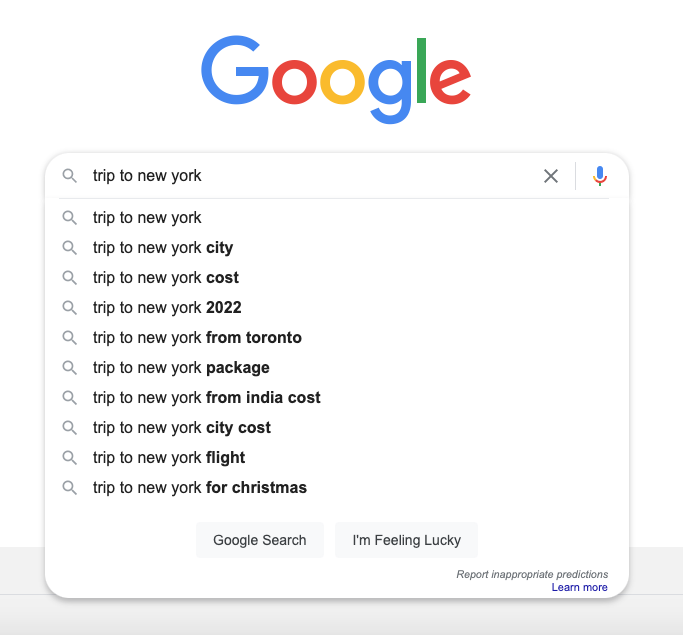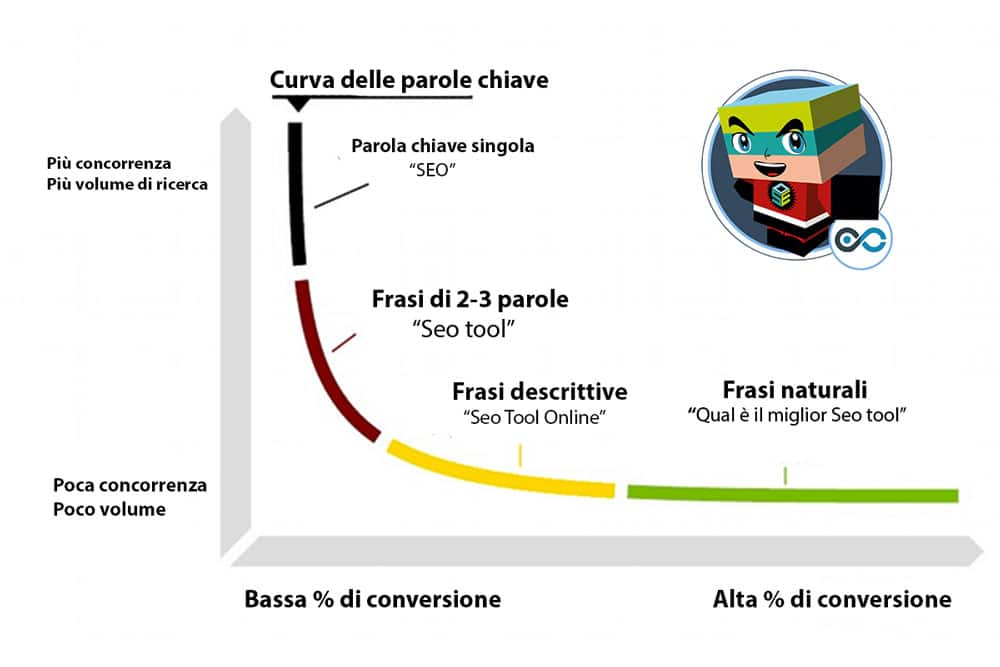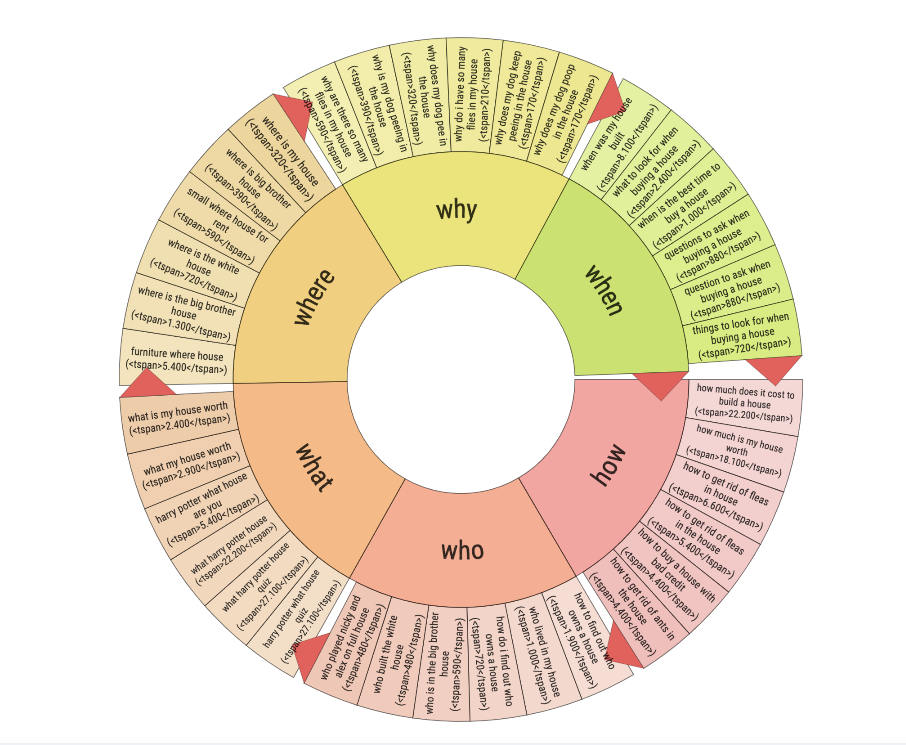The Long Tail theory applied to keywords and SEO
It was way back in 2004 when Chris Anderson, at the time director of Wired USA, introduced for the first time the long tail theory to study economic models, especially those of Amazon and Netflix. According to the US journalist, in short, “products with low demand or low sales volume can collectively build a better market than their rivals, surpassing bestsellers and blockbusters, as long as their sales channel is large enough”. This theory was then used and applied in the world of SEO, but how can this “long tail” theory be useful?
What does long tail keyword mean
Long tail keywords is the name by which we identify the keywords that are typically composed of three or more terms, which are more specific than the more generic search keys, therefore, they have a significantly lower search and traffic volume than exact-match keywords instead.
A definition of a long-tail keyword can thus be “specific and highly targeted search phrase, usually consisting of three or more words”: apparently, taken individually these keywords are often less popular than shorter and more generic keywords, but together they account for the majority of Internet searches.
Take, for example, the keyword “shoes“: it is very generic and highly competitive. But if we extend it to “marathon running shoes,” we have a long-tail keyword, . The latter is much more specific, less competitive and aimed at a more targeted audience.
An immediate way to discover the long tail keyword is to launch a search in the Google bar and take advantage of the autocomplete function, the autocomplete that reports the most frequent branches of the entered term based on the predictions provided by the algorithms.
A simple example concerns the word “house”: a quick search on SEOZoom reveals that the average monthly search volume is 9.9K, but above all that the Keyword Difficulty is 76 and that the Keyword Opportunity is 23, with more than 2 billion pages indexed on the topic. This alone makes us understand that the british web is full of sites that have already obtained Google rankings with content about the “house” and it is therefore complicated to compete for this keyword – without even going to investigate the type of content better ranking or the presence of any SERP features that could further complicate the scenario.
So what can we do if we want to try and make space for ourselves?
The Long Tail Theory applied to SEO
Here is the long tail keyword theory coming to the rescue!
The famous “long tail” that allows you to extend the query and, in this way, intercept more specifically the search intent of users, thus reaching a more profiled user and close to the goal that we set ourselves with our page.
With time, the user has become more and more intelligent in carrying out searches: if before he used only key terms, now he asks real questions to the search engine. To this change, the long tail theory applies perfectly, because it goes to intercept precisely these “queries” that are submitted to Google.
Long Tail Keywords are related to natural language
When a person has to search for something on the Internet, he uses terms that he considers “key” to achieve his goal. We can summarize in this way the categories of users such as:
- The one that performs a search by using one or two, three terms at most.
- The one who asks questions to the search engine using more specific and long keywords, as if talking to the machine naturally.
We put the first user in the “short tail” category, while with the second we actually enter in the “long tail” category.
The first group, short tail, is characterized by:
- Short and generic keywords
- High volume and widely used keywords
- Low conversion rate due to generic terms used
- High competition
The second group, long tail, is mainly characterized by:
- Lower number of searches and therefore lower potential traffic
- Reduced competition
- Increase in the conversion rate
The correct use of the Long Tail theory will allow to have an audience that is increasingly profiled and with a high percentage of conversion, even if this means giving up the bulk of (obviously potential) traffic volume.
The long tail theory connects perfectly with the concept of niche, meaning it is meant to attract those users who are interested in specific products, services, and information. In most cases, this goal can be met with specific and complex searches.
As Anderson noted in the aforementioned article, niche products or services, although individually selling little, together can account for a significant market share, often surpassing the most popular bestsellers, and this concept also applies perfectly to long-tail keywords in the field of SEO.
How to leverage long tail keywords for your SEO strategy
Just because less frequent, these keywords are more easily affordable, especially for a young site; and, no less important, the “sum” of the various long tail keywords that can be intercepted thanks to quality content generates relevant data, often even higher than you can potentially achieve with generic keywords or exact matches.
In addition, it is estimated that long tail keywords account for 70 percent of total Google searches, and with the steady increase in voice searches the share could even increase.
Why long tail keywords are useful for the SEO
But let us try to go deeper and give some food for thoughts on what are the advantages of applying long tail keyword theory during the keyword research phase for our website.
We have already written about the possibility of finding a lower competition than that which is concentrated in short keywords; Moreover, the long and specific keywords are very relevant and help the target audience to find exactly what they are looking for, with positive effects even on conversion rates, according to some analysts are higher than 2,5 times compared to the main keywords.
The theory of long-tail keywords suggests precisely that focusing on a large number of specific, less popular search terms can lead to greater overall traffic than focusing on a small number of popular search terms: even though each long-tail keyword may generate only a small number of searches, the aggregation of many of these keywords can lead to significant search volume, and moreover brings people to the site at a more advanced point in their conversion funnel. Such long keywords are in fact more targeted and attract more qualified visitors to the site: returning to the previous example, a user searching for “marathon running shoes” is likely to be closer to a purchase than one who simply searches for “shoes.”
Intercepting the search intent with long tail keywords
The evolution of Google, from algorithm updates to the attempt to impose itself more and more as “answer engine“, also show that it is increasingly important to focus on contextual research, which now the algorithms are fully able to understand and interpret thanks to the developments of artificial intelligence systems to support the Search.
The goal towards which Google tends to be to provide as a response to a query the page that offers the exact information or at least more relevant to the intent of the user, and using more specific strings there are more chances to present themselves as effective and interesting.
The benefits of a targeted SEO strategy on long tail keywords
Furthermore, by focusing a content on long tail keywords, it could also be possible to place single and short keywords, as well: if the quality of the text is considered relevant and useful by Google, you can also succeed in the enterprise of “killing two birds with one stone”, taking advantage of the positioning of the long tail keywords to push up the other keys.
This kind of strategy also serves to optimize semantic research, especially in relation to the increasing weight of voice searches and the so-called “conversational search”, which are by nature “long tail” and oriented to search/ provide accurate information.
Organic traffic also comes from long tail keywords
The list of the advantages of long tail keyword for an SEO strategy continues with the possibility of adding structured data to the pages of content made starting from the analysis of long tail keywords, to provide complete results in search engines and potentially achieve better positioning.
Finally, and perhaps more specifically, performance analysis frequently reveals that most organic traffic comes from long tail keywords.
Discovering Long Tail Keywords with SEOZoom
An SEO tool like SEOZoom provides all the indications to discover the long tail keywords to use in articles and a look at the chart (accessible from the Related Keyword tab after launching the keyword analysis) allows us to have an immediately intuitable representation of the potential that can be obtained by strategically exploiting the long tail theory.
Thanks to the Keyword Infinity tool, SEOZoom analyzes all the possible useful declinations of the keyword inserted – in our example, house: the keyword graph below is the graphical representation of the main questions and branches starting from the single query, and already suggests us potential long-tailed keywords towards which to orient the article, which in this case is oriented on a more targeted information cut to respond to user needs.
As you can see, there are indications on “who”, “what”, “how”, “when”, “where” and “why”, which basically represent the classic 5 Ws of journalism and the classic theories about content generation.
These kinds of information are also reported in a more direct way in the “Informational keywords” tab, which in fact lists all the possible groups of topics and keyword related to the main key inserted (still “house”) that answer to an informational need of the user. Clicking on the “Transactional keywords” tab, instead, we discover what are the topics and keywords that intercept instead transactional intent, that is, users who are ready to action.
What are the long tail keywords and how to perfect your SEO strategy with these kind of keywords
As we can see from the examples above, from our Italian database: “decorating home” is already interpreted as a long tail and has an average search volume of 18.100; according to SZ it is a key that has a double intent (commercial and informative) and this already makes us understand that any content of this kind must compete with two types of competitors. Simply adding the adverb “how” the intent is clarified: “how to decorate home” has in fact a purely informational intent, with a search volume dropping to 4.400.
We completely changes both the topic and genre with the key “how to make bread at home” (in italian “come fare il pane in casa“), which has a volume of 2000 searches, while “la casa di carta” (the tv show, Money Heist) does boost up the volume of searches to 135 thousand, but adding other terms to the main one (eg the number of the season of interest or the word “streaming”) we can see the volume gradually go down.
Another screen of the keyword graph that can help us find new long tail keywords to insert in our editorial planning is the one dedicated to “Prepositions“, which relates the keyword with the main prepositions or adverbs used on Google – for example, with the preposition for in “home for sale” or “homemade for you”. The last tab of this section is “Actions“, which can serve to better clarify the intent: going with “house”, adding verbs such as buy, rent or sell, for instance, we are understandably oriented on users interested in a transaction, while making or building rather lead to content like guides (such as games to do at home or how to build a house).
Obviously, having chosen a tremendously transversal keyword also the analysis of SEOZoom generates various and extensive results, as happens in the Google Search.
Using SEOZoom to find long tails
Through SEOZoom you can then go and discover these long tail keywords so to be able to organize an editorial plan suitable for the project we are building.
To give another example on our italian database, by entering the starting term “Thailand Trips” (viaggi thailandia) the tool returns all the related terms and long queue that finds in user searches on Google, such as “trips to Thailand costs“, “trips to Thailand advice“, “Thailand trips best time” or “Thailand trips offers” (with a markedly transactional intent).
Other information and suggestions of long tail keywords are also found in the Interest Finder tool, which serves to group the interests of users on specific topics in a mobile vision of quick understanding – always with the example “Thailand trips”, we can see how months certainly represent an element of interest, as well as commercial terms such as “prices”, “last”, “offers” etc.
As always, the tool is a machine and offers results that we must read, interpret and select with the aim of making a real profitable keyword research for the goal of getting visits and conversions from the content we publish.
Long tail keywords are a weapon to optimize the SEO strategy
Ultimately, a content made by focusing on long tail keywords can: provide a quality response to the reader, more accurately center the search intent, better position even other keywords, increase the conversion potential, overcome competition and, in a single expression, optimize the SEO strategy of your site.
In an SEO strategy, especially for a new site, the application of the long tail theory can therefore be a winning choice to capture a super profiled audience. In fact, most of these keywords, as already mentioned, have low competition and are easier to place than “exact match” or too generic keywords, elements to absolutely take into account during the keyword analysis we perform in order to seek visibility on Google and higher returns.











